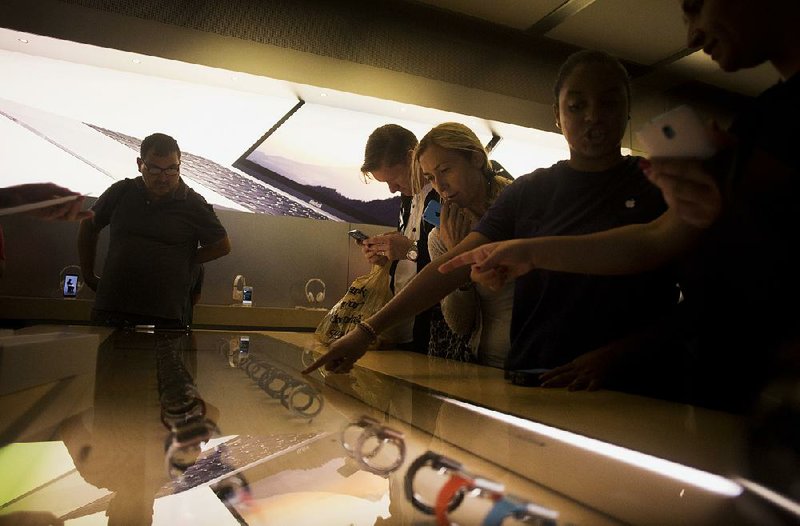About 20 hypertension patients in Louisiana are living the future of health care. When it's time to take a medication, their Apple Watches tap their wrists and give a visual display of the pill so they won't confuse it with other medications.
The patients are taking part in a trial of the device through Ochsner Health System in New Orleans. German software maker SAP SE is also testing and deploying the device to see whether its real-time notification functions increase employee punctuality at meetings and help close sales.
The Apple Watch, introduced earlier this year, has yet to become a mainstream hit. Corporate clients could be key to fueling its growth, just as they've been for Apple Inc.'s iPhone and iPad. The tech giant, which doesn't break out watch sales, probably sold 4.5 million of the devices last quarter, according to Strategy Analytics. That's tiny compared with the 48 million iPhones shipped in the period.
Business users accounted for just 2 percent of watch sales last quarter, according to Neil Mawston, executive director at Strategy Analytics. Apple is likely to focus more on enterprises in the next one to two years, he said. By 2017, businesses will represent 15 percent of sales, according to Daniel Ives, an analyst at FBR Capital Markets.
At Ochsner, doctors just want their patients to feel better. While mobile prompts can be set on smartphones, people may not have them in hand or hear them ring, only to discover later that they missed a dose. That scenario is less likely to happen with a wearable gadget, said Richard Milani, a physician who is leading the Apple Watch trial with the hypertension patients.
"We thought the watch was unique in that it had durability," Milani said. Tools that help people remember to take medication or engage them in exercise "can have a positive effect on many things including blood pressure," he said.
More businesses are starting to take notice. A Salesforce.com Inc. survey of 1,455 business professionals this year found more than a third use or plan to use wearable technology. Almost 80 percent of that group said the devices will be key to its future success.
Enterprise accounted for about 11 percent of Apple's total sales in the fiscal year that ended in September, the company said during an earnings call last month. It has been courting businesses in the past two years through partnerships with Cisco Systems Inc. and IBM, among other companies. IBM said it has 14 apps that work on the watch related to such industries as health care, financial services and public safety. Salesforce is working with developers to build more apps, while BlackBerry Ltd.-owned software maker Good Technology has released an Apple Watch version of its corporate email application.
While smartphones are viewed as must-haves for business users, for many companies the watch is more of a luxury item. The price ranges from $349 for the lowest-priced models and stretch into the thousands. In comparison, Sprint Corp. has a limited-time offer for an iPhone for as low as $1 a month with a trade-in and service plan.
"I don't think we'll have a good narrative outside of employees bringing them into work for at least another year or longer," said Ben Bajarin, an analyst at Creative Strategies LLC.
Business apps for the Apple Watch may first bump up consumer sales -- just as the abundance of iPhone and iPad apps for business initially did -- with en masse company purchases coming later. There are now more than 13,000 consumer and business apps, up from about 3,000 when the Watch debuted in April, according to tracker App Annie.
"Where I see a lot of similarities to smartphones, adoption happened bottom up, with consumers bringing phones into the enterprise," Oliver Conze, a global vice president at SAP, said in an interview. "I expect the same for wearables."
SAP bought several hundred of the watches to see if they would improve employee productivity and help close deals. One of the apps it's using is intended to help salesmen prepare for client meetings on the go. The app sends an alert when it's time to leave for the meeting and provides insight about attendees and potential deals.
"It should translate into closing more deals," Conze said.
Information for this article was contributed by Adam Satariano of Bloomberg News.
SundayMonday Business on 11/16/2015
